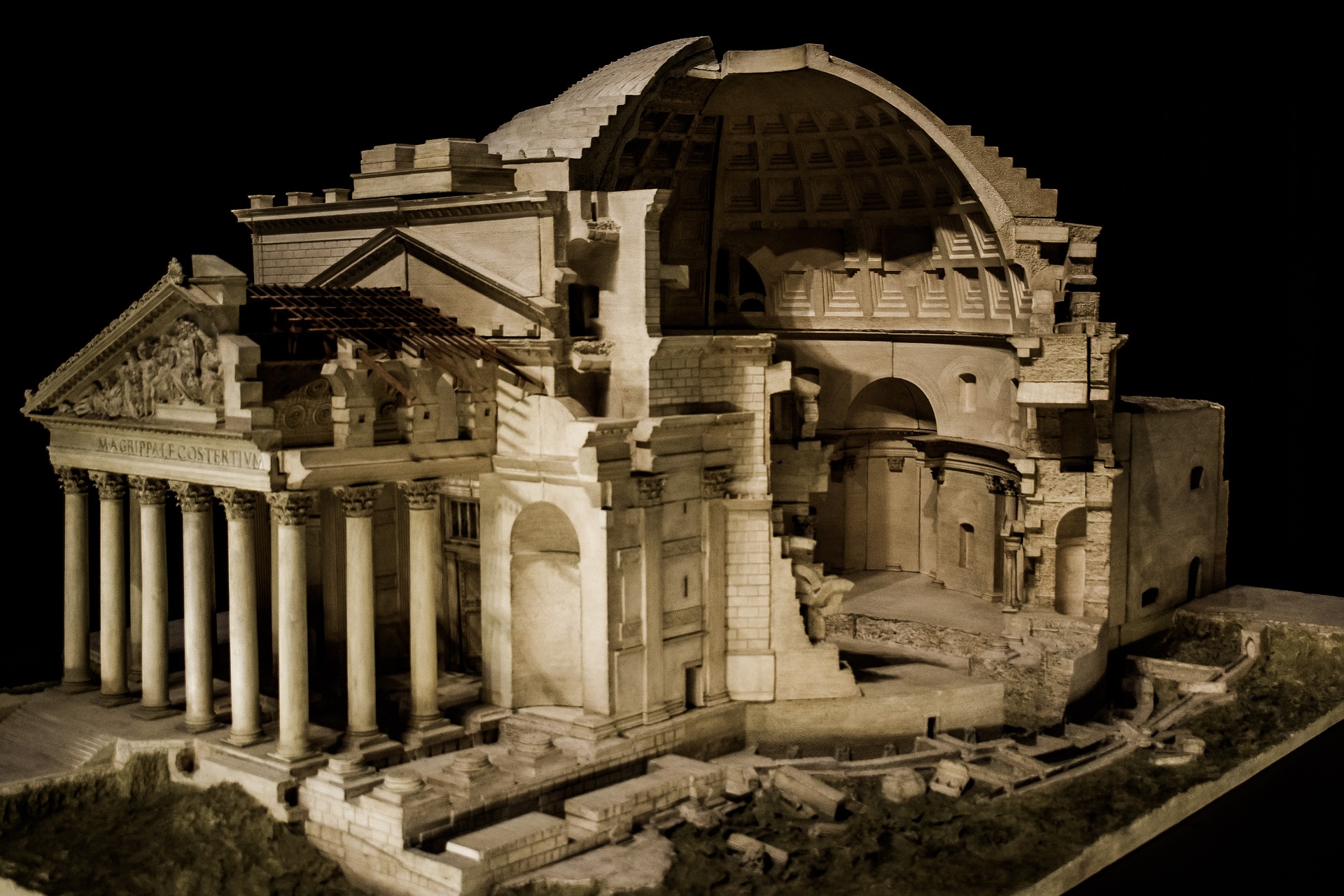Technological progress, it turns out, is not a straight line. Over the ages, great discoveries and useful instruments have been lost and forgotten, only to be invented again centuries later. Likewise, printing technology quickly obscured centuries of specialized book production that catalogued esoteric knowledge of the cosmos and natural world. There remain persistent mysteries discovered in the archeological record and ancient texts that contemporary researchers, armed with the latest technologies, are only beginning to decode.
◊
The Pantheon in Rome is one of the architectural and engineering marvels of what we tend to dismiss as the ancient world. Completed about 126 C.E., its freestanding interior dome is 142 feet high and 142 feet wide. The open oculus at its apex has a circumference of 142 feet, proportioned to distribute the roof weight downwards to brace the building without interior support or frame.
Constructed as a temple to all of Imperial Rome’s gods, it was repurposed as a Christian church in 609 C.E. and so survived the wreckers that leveled hundreds of pagan sites across the Roman Empire. Entering its third millennium, the Pantheon remains the largest freestanding domed structure in the world.

A cutaway model of the Pantheon (Credit: Dimitris Vetsikas, via Pixabay)
In the 15th century, with a revival of learning and trade after waves of plague, Renaissance builders began to study the engineering behind the Pantheon and other monumental Roman structures such as the Colosseum, city walls, aqueducts, tombs, and harbor installations. The astonishing fact was that, after eight centuries of complete neglect, Rome’s infrastructure was remarkably intact. Far more damage to the Colosseum was done by 15th century workers who stripped its marble façade and bronze fixtures than in the previous thousand years it spent open to the elements.
This long-term endurance was thanks to a very mundane building material, the ingredients of which remained a mystery until very recently.
Watch Ancient Inventions now on MagellanTV.
A Durable Material for the Eternal City
Rome, it turned out, was not built in a day but with a quick-setting concrete that the ages have shown is nearly impervious to decay. And by the way, it could also harden underwater to form harbor walls and fortifications. But, though Rome’s buildings endured, the knowledge of how to make this fantastic material did not survive the Empire.
The Pantheon’s dome was constructed with circular molds for poured concrete that were stacked, as each level dried, atop each other. Gradually smaller molds formed ascending layers, each lighter than the one under it, to form a perfect interior hemisphere.
Centuries later, concrete technology reappeared in England. Portland cement, much stronger than the Roman material but nowhere near as durable, came along in the 1750s. However, it wasn’t until 2017 that spectral chemical analysis and electron microscopy revealed the key to Roman concrete.
The “secret” ingredient turns out to be pumice mined from the slopes of Mount Vesuvius that was particularly rich in a rare calcium silica. When mixed with sand, quicklime, and water, it produced a slurry that not only hardened quickly, but formed a crystalline structure impervious to any further drenching.
The technology vanished for several reasons. The need for large-scale engineering projects disappeared as the Western Roman Empire fractured, while the bureaucracy needed to coordinate such things packed up and sailed to Constantinople, where Vesuvius pumice was in short supply.
So, the recipe for Rome’s marvelous concrete wasn’t lost so much as left behind. Its fantastic properties were specific to a particular place and time. Technology, then, is less a matter of progress than a product of specific need. Though the Chinese famously invented gunpowder, paper, and movable type, it was the fractured and rival states of Renaissance Europe that took these inventions to wage war and to mass-produce volumes of early novels, histories, essays, and competing tracts of religious doctrine.
Earlier methods of book production were quickly obsolete. What were once hand-crafted items made for a select few became mass-produced products intended for an ever-growing audience of readers, as the new books also created markets for literacy.
Because books were mainly printed in the dialects of capital cities, such as the English of London and the French of Paris, they standardized languages and helped define national identities as nation states evolved in the 16th and 17th centuries.
Teams of scribes, artists, and artisans who produced unique, handmade, often beautiful, books out of wood and calfskin lost their jobs. An entire industry vanished leaving behind ancient libraries of unique, finely-crafted esoteric items, made for a select few, that now appealed only to scattered collectors.
The Mysterious Voynich Manuscript
One of the most amazing of these rarities sits now at Yale University’s Beinecke Library. Named for the Polish book dealer who purchased it in 1912, the Voynich Manuscript is a profusely illustrated 234-page book, hand-written on calfskin vellum. Its ornate drawings detail plant life, a study of the stars, and, apparently, a medical treatise. The word “apparently” is appropriate because the Voynich manuscript is written in a completely unknown script, in an as-yet-to-be-determined language.
The Voynich codex has become a focus of worldwide interest and intense study in the Internet age. While no one can say for certain what it is, it’s not a recent forgery. Its pages have been radiocarbon dated to the early 15th century. Spectrographic scans show the chemical compounds in the inks date also to that time. Its cursive lettering was inscribed by a quill pen without any obvious errors or corrections.
Direct ownership of the Voynich Manuscript can be traced to 1600 and the library of Holy Roman Emperor Rudolph II. Before that, some think it belonged to the notorious English alchemist John Dee, who owned what was reputed to have been the largest collection of magical texts ever assembled.
Contemporary computer analysis replaces the esoteric alphabet with contemporary symbols to map its approximately 35,000 word forms. Regularly recurring characters, and slight use of Latin and High German, reflect a logical linguistic form. However, statistical tracking of the 25 distinct “letters” shows that the design does not fit any Indo-European frame. This might indicate the presence of an elaborate cipher or code. Several cryptographic methods, such as words made from scrambled letters, or consisting only of consonants, are possible inside the text.
 The peculiar script of the Voynich Manuscript assigned to contemporary letters for computer analysis (Credit: VonHaarberg, via Wikicommons)
The peculiar script of the Voynich Manuscript assigned to contemporary letters for computer analysis (Credit: VonHaarberg, via Wikicommons)
As such, the Voynich Manuscript has beguiled, and frustrated, cryptographers – including a team from the U.S. National Security Agency – for the past century. Recently, Canadian researchers scanned a portion of the text through three algorithmic filters in an attempt to identify an underlying language.
Every language has its own pattern of letter use, including repetition of paired figures, that give it a unique profile. Using the five prevalent languages found in medieval manuscripts – Latin, Arabic, Hebrew, and early forms of Italian and Spanish – the CPU-intensive processing found the highest correlation with Hebrew, a written language that usually does without vowel characters. That established, the anagram algorithm then presented word possibilities out of the textual “noise” (imagine trying to grasp a Shakespeare play through waves of radio static).
Initial results were promising. For example, Hebrew words for “farmer” “air” and “light” appeared in the botanical passages. While an intriguing step forward, further progress now depends on much more textual analysis, along with the added assistance of scholars of medieval Hebrew. The AI translation of the Voynich Manuscript’s first line, “She made recommendations to the priest man of the house and me and people” is both tantalizing and indicates that much more work remains to be done.
The Antikythera Mechanism Yields Its Secrets
If modern science still struggles to decipher one mystery, it has come a long way to reveal the workings of another – one of the most astounding pieces of lost technology ever recovered, the Antikythera Mechanism.
It was discovered in 1901 in the wreckage of a treasure ship by sponge divers off the Greek island of Antikythera. They saw first a large bronze gear embedded in a solid mass of material in the remains of a wooden case. Researchers dated the sunken ship to about 60 B.C.E. Now housed at Greece’s National Museum of Archaeology, the single slab fractured into seven main segments and many smaller ones when it dried. A resurvey of the shipwreck in the 1970s uncovered other parts, while more have been found in museum storage, overlooked for a century. These constitute a total of 82 pieces that make up a 3-D jigsaw puzzle.

The main drive wheel of the Antikythera mechanism (Credit: Marsyas, via Wikicommons)
An early researcher proposed its function as a planetary tracking device, with a front display of nested rings that, when cranked by a missing handle, reproduced the synchronized motions of the visible planets. But the mechanism’s true sophistication wasn’t grasped until renowned science historian Derek Price published a paper in 1974 detailing X-ray and gamma ray images that showed layers of gears inside the main section.
The recovered pieces made up about one-third of a driveshaft-powered system that fit inside a wooden box, about the size of a large book, with front and rear displays. The works for the back mechanism were the most intact, and apparently ran a system of concentric dials and pointers that measured a 19-year cycle of lunar and solar months.
In 2008, British researchers made a far more sophisticated X-ray tomographic scan of the parts that revealed layers of information previously unseen. These included Greek inscriptions that gave instructions for the mechanism’s use, noting prime numbers for planetary cycles. From this researchers were able to deduce exact ratios for a 30-gear drivetrain that reproduced the observed irregularities of planetary orbits, recorded the phases of the Moon, and tracked the 12 signs of the zodiac.
Creating first an animated computer model of a completed device that incorporated a proposed gear system that fit onto existing parts, the British team unveiled a working reproduction in March 2021.
Though it’s an exquisite example of Greek mathematics and invention, presumed to have been built between 200 and 85 B.C.E, the reconstructed mechanism was found to have inaccuracies based on the Greeks’ fundamentally incorrect model of the solar system.
Dating the Antikythera device to 200 B.C.E. could connect it to the workshop of the brilliant Greek engineer and astronomer Archimedes, who was reported to have made similar planetary tracking devices.
The lingering question remains: Why did this meshed-gear technology vanish in Europe until the first clocks appeared 1,500 years later? Interestingly, the gear design deduced to make the working model Antikythera has been shown to function perfectly in the recovered odometer mechanisms that Romans used to set exact mile markers on the roads that defined their empire.
We may infer from this that the Greco-Roman world was far more interested in factoring space than keeping track of time. Time, ever subjective, was mostly measured by distance. Sundials and lunar calendars were good enough for the everyday business of agriculture, trade, and conquest.
Technologies, be they for building aqueducts or crafting elaborate, esoteric texts for a special audience, will last only so long as needed. Western civilization vanquished distance in the 20th century. So now we track time to an exacting degree. Schedules and deadlines rule society because Time is Money. We work overtime, get time off, take timeouts, even time our workouts. The biggest mystery now may be how we might rediscover the lost art of downtime.
Ω
Title Image: The Roman Pantheon (Credit: Jfabrix101/Wikicommons)

